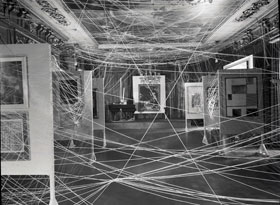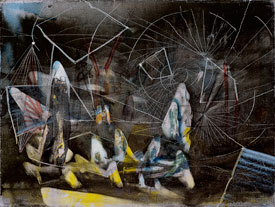Spatial investigation was one of Matta’s fundamental artistic preoccupations. The artist, who trained as an architect in Santiago de Chile then worked in Le Corbusier’s studio after he arrived in Europe in 1931, maintained a pronounced interest throughout his career in the study of dimensions and their representation.
Matta’s early drawings and paintings of the late 1930s, executed shortly after he abandoned his career as an architect and joined the Surrealist group, already focused on an innovative concept based on space. Using the term “psychological morphology”, Matta depicted both interior reality and the exterior world. “His most important contribution was the discovery of regions of space unexplored in the realm of art” Marcel Duchamp noted in 1945. “He followed modern physicists in his quest for a new space which was not to be confused with threedimensional illusionism. [...] Although still very young, Matta is the most profound painter of his generation.”
It was precisely this interest in modern physics with its theories of non-Euclidian geometry that made Matta the bright young hope of Surrealism. He combined the new findings of psychoanalysis—a preoccupation shared by his fellow group members—with the desire to create a new vocabulary in order to depict the reality discovered by contemporary science. A rejection of traditional perspective and an interest in the depiction of the fourth dimension were latent in Matta’s work by the time he settled in New York in 1939.
The artist soon began to associate with the Surrealists who took refuge in Manhattan during World War II. He made friends with Marcel Duchamp who was also fascinated by modern physics. His weekly meetings with him were a revelation for Matta who revered Duchamp’s solutions for going beyond the traditional depiction of perspective. Duchamp’s reflections on the fourth dimension in works such as The Large Glass , which Matta was able to see in Katherine Dreier’s house, were crucial for his subsequent evolution.
Matta expressed Duchamp’s concept of transparency in his ownLarge Transparencies while the latter’s concept of passage revealed to him that movement and time in space could be expressed through painting. Matta admired Duchamp’s championing of the mechanical world and his absurdist and cynical but highly intelligent vision of his creative activities. In 1942 Matta’s work was included in the legendary exhibition First Papers of Surrealism at the Whitelaw Reid Mansion, where Duchamp in turn installed metres and metres of string that covered the entire space of the room like a cobweb. The elimination of perspective and the multiplication of vanishing points are evident in works by Matta such as Untitled of 1942-1943, also in the collection of the Museo Thyssen-Bornemisza.
-
- First Papers of Surrealism exhibition withe the installation by Marcel Duchamp, New York, 1942
- Tipo:
- Photo John D. Chiff
- Medidas:
- Úbicacion:
- Philadelphia Museum of Art. Gift of Jacqueline, Paul and Peter Matisse in honour of their mother, Alexina Duchamp, 1998
- © Philadelphia Museum of Art/Art Resource/Scala, Florence
- Numero de inventario
-
- Autor:
- Matta
- Título:
- Untitled, 1942-3
- Medidas:
- Úbicacion:
- Inv. 670 (1975.27)
- © Thyssen-Bornemisza Museum
- Numero de inventario


